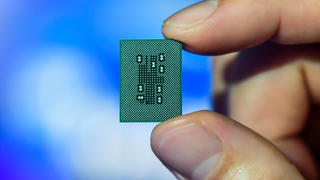Arm Unveils Armv9 Instruction Set Architecture
The Future of SoCs

Arm this week announced Armv9, its latest instruction set architecture that will power a broad range of processors and system-on-chips that will be launched in the coming years. The new ISA promises to enable designers to build SoCs with multiple special-purpose accelerators for artificial intelligence (AI), machine leading, digital signal processing (DSP), and security. Arm believes that SoCs and CPUs with specialized accelerators will better address existing and upcoming challenges of computing.
Arm's Armv8 ISA unveiled a decade ago introduced 64-bit instructions, advanced SIMD instructions, cryptography extensions, virtualization, AMBA5 CHI (coherent hub interface), and a number of others. To a large degree, the Armv8 was a development of the general-purpose processor paradigm, which implicates that a CPU should perform all the tasks that a system needs. While this concept has been around for some time and will continue to exist for many reasons, special-purpose accelerators such as those used for AI/ML, graphics processing, IoT, and DSP are not only faster, but are also more energy efficient. To that end, Arm decided to build an ISA that is not only generally fast, but is more suitable for heterogeneous SoCs with accelerators aimed at all types of applications, from IoT to servers.
It is noteworthy that Arm expects CPUs based on its Armv9 instruction set architecture to offer a more than 30% performance increase over the next two generations of mobile and infrastructure processors (codenamed Matterhorn and Makalu), so performance of PCs, servers, smartphones, and other Arm-powered devices will continue to increase at a rather rapid pace.

But the addition of heterogeneous processing capabilities will offer even more substantial gains, according to Arm. To make heterogeneous SoCs more robust, Arm promises new methods to increase frequency, bandwidth, and cache size, and reduce memory latency to amplify the performance of Armv9-based CPUs.
"The increasing complexity of use cases from edge to cloud cannot be addressed with a one-size-fits-all solution," said Henry Sanders, corporate vice president and chief technology officer, Azure Edge and Platforms at Microsoft. "As a result, heterogeneous compute is becoming more ubiquitous, requiring greater synergy among hardware and software developers."
One of the key features of Arm's v9 ISA is the Confidential Compute Architecture (CCA) that protects potions of code and data from access or modification while in-use by making computations in a hardware-based secure environment. Arm's CCA relies on the so-called Realms that are separated from both the secure and non-secure worlds. To some degree, Realms can be compared to sandboxes used by software. Meanwhile, Realms will use both software and hardware resources. Realms will be useful not only for client devices such as PCs or smartphones, but for servers as well as edge computing devices.
"A good example of this synergy between hardware and software are the ArmV9 confidential compute features which were developed in close collaboration with Microsoft," added Sanders. "Arm is in a unique position to accelerate heterogeneous computing at the heart of an ecosystem, fostering open innovation on an architecture powering billions of devices."
Stay on the Cutting Edge
Join the experts who read Tom's Hardware for the inside track on enthusiast PC tech news — and have for over 25 years. We'll send breaking news and in-depth reviews of CPUs, GPUs, AI, maker hardware and more straight to your inbox.
In addition, to address demanding AI/ML and DSP workloads, Arm teamed up with Fujitsu to design Scalable Vector Extension 2 (SVE2) technology for Armv9. Fujitsu's custom Arm processors that are used for the Fugaku supercomputer already support SVE instructions. Going forward Arm intends to add 'substantial enhancements in matrix multiplication within the CPU,' which is a similar approach that Intel will support with its AMX technology featured by its upcoming Sapphire Rapids CPUs.
"The launch of the Armv9 architecture signals a new era for our company; a globally-pervasive platform driving secure AI-driven computing that will enable our ecosystem of more than 1,000 partners well into the 2030s," said Simon Segars, CEO of Arm. "The Armv9 roadmap contains multiple new elements addressing the need for specialized compute from the smallest sensor to the largest supercomputer, but none are as important as the need to secure the world’s data."
To date, numerous companies already announced support for Armv9, including Google, Foxconn, Microsoft, Nvidia, NXP, Marvell, Renesas, Unity, Samsung, Siemens, Volkswagen, Zoom, and others.

Anton Shilov is a Freelance News Writer at Tom’s Hardware US. Over the past couple of decades, he has covered everything from CPUs and GPUs to supercomputers and from modern process technologies and latest fab tools to high-tech industry trends.
Most Popular


